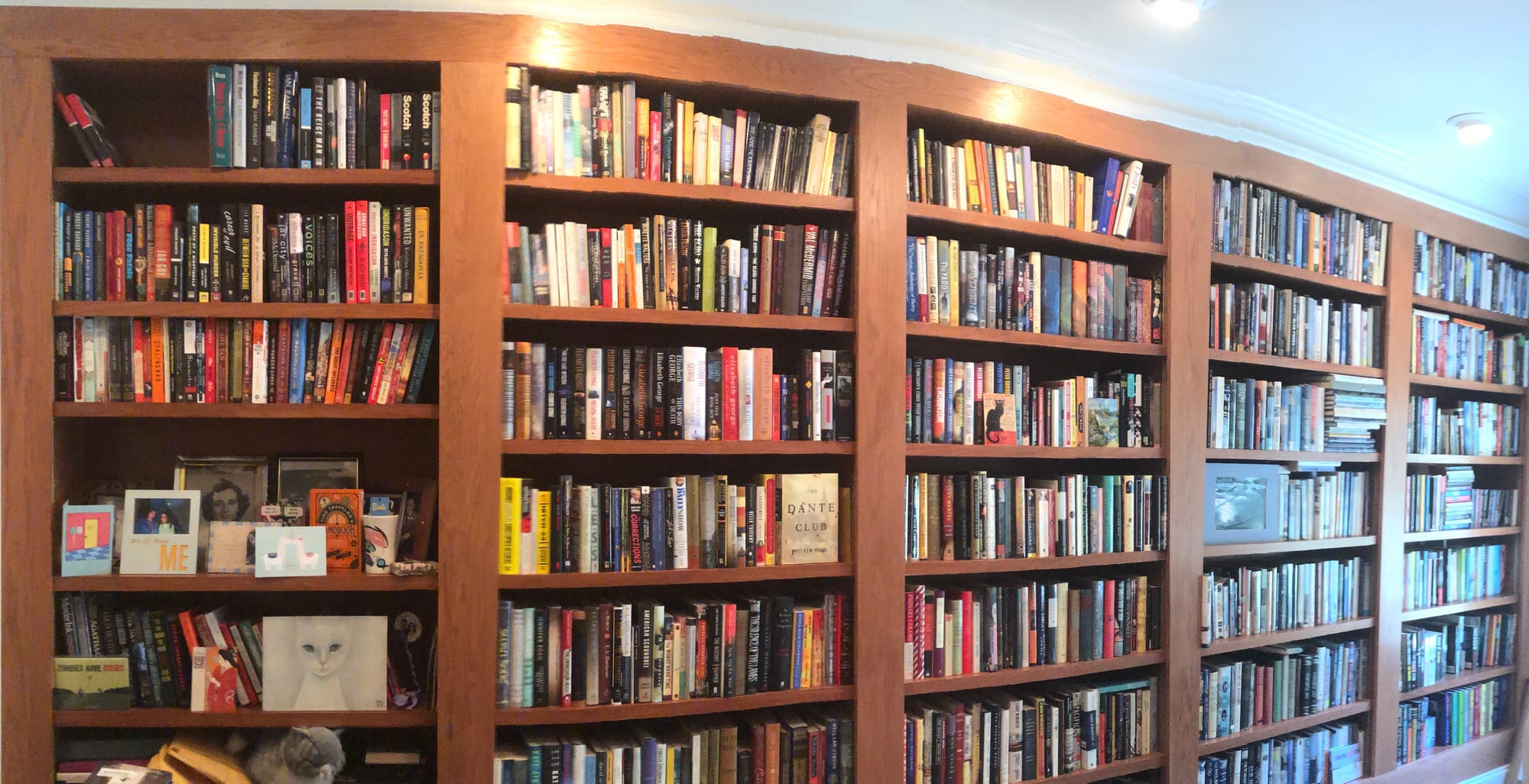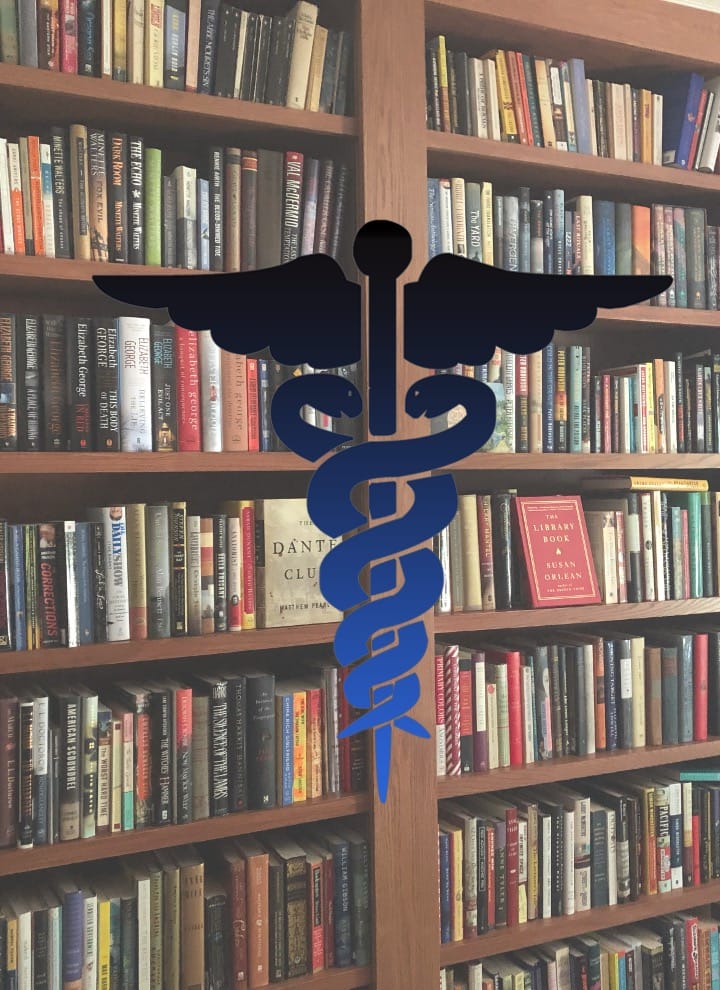For reasons that DEFY EXPLANATION, I recently took stock of the books in my library about medicine, health and science. These include biographies, histories, case studies, scientific studies, and related topics. I was somewhat surprised when the total count reached 25!
I can trace my initial interest in these topics to Dr. Oliver Sacks’ “The Man Who Mistook His Wife for a Hat” first published in the US in 1998. I was fortunate enough to hear Dr. Sacks speak that year in the now-defunct Borders Bookstore in Atlanta.

I now own ten books by Dr. Sacks, including the above, but I’ve already covered his books in a previous blog post, #5 The Marvelous Dr. Sacks. Suffice it to say I can strongly recommend ANY of his books, but do not miss the book pictured above, “Awakenings”, “Uncle Tungsten” (more of an autobiography), and “Musicophilia”.
So, moving on to the other books in La Biblioteca de Algonquin. One interesting thing I noted is that of the other 15 books, I have one book each by 15 different authors. I’ve divided the books into two blogs; the first and longest being medical histories. Enjoy!
MEDICAL HISTORY:
“The Mold in Dr. Florey’s Coat: The Story of the Penicillin Miracle” by Eric Lax
I just finished this book a week ago; it was not only fascinating, but an excellent corrective to the commonly held belief that Dr. Alexander Fleming not only discovered penicillin, but was also responsible for its development, production and usage as a medical breakthrough of historic proportions.

The many critical contributions of other scientists, including the above-mentioned Dr. Florey, are highlighted in this wonderfully researched and well-written book. The long, convoluted path to researching penicillin’s effects, discovering how to produce it in sufficient quantities, and using it to cure formerly deadly infections and diseases is beautifully explained.
“The Anatomist: A True Story of Gray’s Anatomy” by Bill Hayes
Another great example of a book with an illuminating story not as well known as it should be. From The New Yorker: “The book coincides with the hundred-and-fiftieth anniversary of “Gray’s Anatomy’s” first publication…

…”Fascinated by the fact that little was known about the famous book’s genesis, Hayes combed through nineteenth-century letters and medical-school records, learning that, besides Henry Gray, the brilliant scholar and surgeon who wrote the text, another anatomist was crucial to the book’s popularity: Henry Vandyke Carter, who provided its painstaking drawings. Hayes moves nimbly between the dour streets of Victorian London, where Gray and Carter trained at St. George’s Hospital, and the sunnier classrooms of a West Coast university filled with athletic physical therapists in training, where he enrolls in anatomy classes and discovers that “when done well, dissection is very pleasing aesthetically.” Follow Bill Hayes (also a wonderful photographer) on Twitter at @BillHayesNYC.
“The Sick Rose: Disease and the Art of Medical Illustration” by Richard Barnett
This book is an excellent companion to “The Anatomist”.

From Will Self in The Guardian: “The strange, symbiotic relationship between medicine and social oppression is here given full-colour form: not only by anatomical illustrations of paupers’ and criminals’ corpses, but also by what – were they not so disfigured – would be regarded as straightforward portraits of the leprous and the syphilitic, the tubercular and the cancerous … Richard Barnett’s superbly erudite and lucid accompanying text would really suffice in itself as an introduction to the history of western medical science.” (Italics mine). Follow Richard Barnett on Twitter at @doctorbarnett.
“The Butchering Art: Joseph Lister’s Quest to Transform the Grisly World of Victorian Medicine” by Dr. Lindsay Fitzharris
b>Dr. Lister lives on in modern times in the name of the ubiquitous mouthwash, Listerine. However, his contributions to saving the lives of surgical patients, whose survival percentage was very low due to infection, cannot be overstated. Dr. Fitzharris’ book is a great read! This book was the winner of the PEN / E. O. Wilson Literary Science Writing Award, the Staff Pick on NPR’s best books of 2017, and was listed in the New York Times‘ “10 New Books We Recommend This Week”. She has a great twitter account, @DrLindseyFitz AND, (fun fact) her husband, Adrian Teal, is a magnificent caricaturist who you can follow at @TealCartoons.

In The Butchering Art, Dr. Fitzharris reveals the shocking world of nineteenth-century surgery and shows how it was transformed by advances made in germ theory and antiseptics between 1860 and 1875. She conjures up early operating theaters—no place for the squeamish—and surgeons, who, working before anesthesia, were lauded for their speed and brute strength. These pioneers knew that the aftermath of surgery was often more dangerous than patients’ afflictions, and the were baffled by the persistent infections that kept mortality rates stubbornly high. At a time when surgery couldn’t have been more hazardous, an unlikely figure stepped forward: a young, melancholy Quaker surgeon named Joseph Lister, who would solve the riddle and change the course of history. I cannot recommend this book highly enough!
“The Great Influenza: The Story of the Deadliest Pandemic in History” by John M. Barry
This book could not be more timely given the current news about the coronavirus, or as it’s now known, COVID-19. I enjoyed it a great deal and think that it’s ripe for a re-read just about now!

From the Boston Globe: “John M. Barry’s “The Great Influenza,” a sobering account of the 1918 flu epidemic, compelling and timely.The 1918 pandemic took a staggering toll — worldwide, 50 million to 100 million lives; in the United States, 675,000. More people died from mid-September to early December in 1918 than have died of AIDS in its 24-year scourge, Barry notes. When the flu struck in 1918, it was killing, Barry writes, “in some new and awful way.” As an internal Red Cross report put it, the flu spread “a fear and panic . . . akin to the terror of the Middle Ages regarding the Black Plague.” Barry’s descriptions of the disease’s ravages are gruesome.” Follow John M. Barry on Twitter at @johnmbarry.
“The Poisoner’s Handbook: Murder and the Birth of Forensic Medicine in Jazz Age New York” by Deborah Blum
A fascinating Jazz Age tale of chemistry and detection, poison and murder, The Poisoner’s Handbook is a page-turning account of a forgotten era.

In early twentieth-century New York, poisons offered an easy path to the perfect crime. Science had no place in the Tammany Hall-controlled coroner’s office, and corruption ran rampant. However, with the appointment of chief medical examiner Charles Norris in 1918, the poison game changed forever. Together with toxicologist Alexander Gettler, the duo set the justice system on fire with their trailblazing scientific detective work, triumphing over seemingly unbeatable odds to become the pioneers of forensic chemistry and the gatekeepers of justice. Follow Deborah Blum on Twitter at @deborahblum.
In 2014, PBS’s “American Experience” released a film based on The Poisoner’s Handbook. Here is the link.
“The Great Mortality: An Intimate HIstory of the Black Death, the Most Devastating Plague of All Time” by John Kelly
From Publishers Weekly:”Drawing on recent research as well as firsthand accounts, veteran author Kelly (Three on the Edge, etc.) describes how infected rats, brought by Genoese trading ships returning from the East and docked in Sicily, carried fleas that spread the disease when they bit humans. Two types of plague seem to have predominated: bubonic plague, characterized by swollen lymph nodes and the bubo, a type of boil; and pneumonic plague, characterized by lung infection and spitting blood. Those stricken with plague died quickly…

…Survivors often attempted to flee, but the plague was so widespread that there was virtually no escape from infection. Kelly recounts the varied reactions to the plague. The citizens of Venice, for example, forged a civic response to the crisis, while Avignon fell apart. The author details the emergence of Flagellants, unruly gangs who believed the plague was a punishment from God and roamed the countryside flogging themselves as a penance. Rounding up and burning Jews, whom they blamed for the plague, the Flagellants also sparked widespread anti-Semitism. This is an excellent overview, accessible and engrossing.” Follow John Kelly on Twitter at @JohnKelly_NS.
The Ghost Map: The Story of London’s Most Terrifying Epidemic—and How it Changed Science, Cities and the Modern World by Steven Johnson
What a riveting page turner this was; my favorite kind of history that reads like a thriller! Describing London as both a city and culture experiencing explosive growth, Johnson builds the story around physician John Snow. In the face of a horrifying epidemic, Snow posited the then radical theory that cholera was spread through contaminated water rather than through miasma, or smells in the air. Against considerable resistance from the medical and bureaucratic establishment, Snow persisted and, with hard work and groundbreaking research, helped to bring about a fundamental change in our understanding of disease and its spread.

Johnson weaves in overlapping ideas about the growth of civilization, the organization of cities, and evolution to thrilling effect. From Snow’s discovery of patient zero to Johnson’s compelling argument for and celebration of cities, this makes for an illuminating and satisfying read. Follow Steven Johnson on Twitter at @stevenbjohnson.
Dr. Mütter’s Marvels: A True Tale of Intrigue and Innovation at the Dawn of Modern Medicine by Cristin O’Keefe Aptowicz
I’ve read this book twice, and will come back to it again, I’m sure. In the meantime, I will also be making plans to visit the Mütter Museum in Philadelphia, PA; it sounds fascinating! “America’s finest museum of medical history, the Mütter Museum displays its beautifully preserved collections of anatomical specimens, models, and medical instruments in a 19th-century “cabinet museum” setting. The museum helps the public understand the mysteries and beauty of the human body and to appreciate the history of diagnosis and treatment of disease.”

From NPR Books: “With clinical precision, Aptowicz lays bare the facts of Mütter’s colorful, tumultuous life. But those are only the bones of the book. Through anecdotes, rich context and an unabashed artistic license on par with Erik Larson’s novelized historical accounts like The Devil in the White City and Thunderstruck, she injects Dr. Mütter’s Marvels with warmth and wit.
In particular, the doctor’s borderline fetishization of grotesque medical curios — which would come to rest in Philadelphia’s Mütter Museum, still standing and attracting tens of thousands of visitors annually — comes across as both a quirk and a virtue, the result of his fascination with how the human body can be not only healed, but re-sculpted. His work in plastic surgery underscores a larger point that Aptowicz reveals masterfully: Vanity and wanting to be accepted in society are two very different things, then and now.” Follow Cristin O’Keefe Aptowicz on Twitter at @coaptowicz.
The Tale of the Dueling Neurosurgeons: The History of the Human Brain as Revealed by True Stories of Trauma, Madness and Recovery by Sam Kean
From Kirkus Reviews: “For centuries, brain injuries have been documented and analyzed as doctors attempted to comprehend how the brain functions. How is it that a man can survive a spike through his skull, and yet his peer drops dead after a seemingly minor bump? In tale after tale, best-selling author Kean…provides a fascinating, and at times gloriously gory, look at how early efforts in neurosurgery were essentially a medical guessing game…

…”Those who survived the wounds or seizures were often irrevocably changed as new personality traits emerged, giving doctors clues about how the brain altered itself in a struggle to function despite trauma. Major discoveries about how the brain works were borne from inspecting damaged brains in the context of the injured person’s symptoms. Compulsively readable, wicked scientific fun.”
I can also recommend “The Disappearing Spoon” by the same author. Follow Sam Kean on Twitter at @sam_kean.
NEXT UP: CASE STUDIES, GENETICS & GIRLS WHO GLOW IN THE DARK





